Social life In the past, as now, much social life revolves around functions organised to raise money for community projects like schools, health services, sports facilities, churches, show grounds, Institutes and memorials.
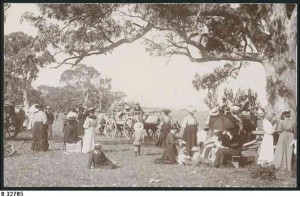
State Library of South Australia B322785. Sunday School Picnic near Quorn, around 1900. People managed to relax despite wearing clothes we now see as heavy and uncomfortable.
Institutes
Libraries and Mechanics’ Institutes were linked in South Australia from early in colonial life. ‘They were often supported by the colonial governments – usually by land grants and cash assistance. They were particularly popular in country areas where their role often went far beyond their “library” function to a general focus for the community’s cultural activities. Because of this important role and because of the support of the colonial governments, Mechanics’ Institute buildings were frequently quite imposing and they form an important part of Australia’s built heritage.’ http://australia.gov.au/about-australia/australian-story/libraries-in-australia
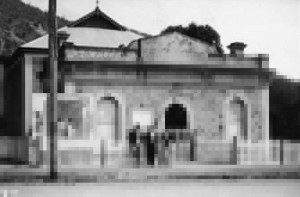
State Library of South Australia B8557. The Melrose Institute, 1932. Nuccaleena Miners Institute opened in 1861. Here a band played (‘bones’, violin, triangle, drum and a concertina); men studied, listened to visiting speakers or took part in ‘innocent recreation’. Church bazaars, concerts, balls were all held to raise money for the Hawker Institute, for instance. Local singers and a brass band performed. Music was clearly popular. Many towns had their own brass bands. Concerts and balls were held after big events like agricultural shows in centres such as Hawker – after the 1891 and 1895 Hawker shows there was a concert in the Institute hall, followed by a ball.
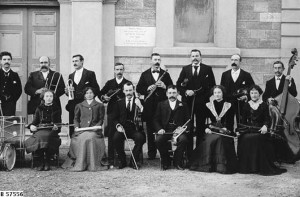
State Library of South Australia B57556. Members of a small orchestra in Quorn; players including women as well as men and are grouped outside the Town Hall, around 1893.
The next two photographs show brass bands from the region. The first one was taken around 1890. The second one is taken around 1920, after the First World War. Look at the difference in the ages of the players in the two groups. There are no young adult men after the War. And can you see any differences in their clothes? Do they look more prosperous before or after the War?
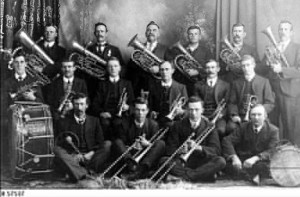
State Library of South Australia B57537. Brass band at Quorn, around 1890.
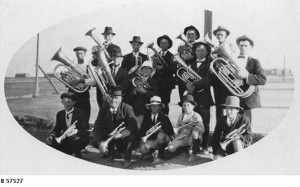
State Library of South Australia B57527. Brass band, thought to be at Quorn, around 1920
Sports
– Favourite sports played from early on were cricket, athletics and horse racing.
– Angepena hosted its first race meeting in 1861.
- The publican from Stirling brought up a booth, no doubt enjoyed by the 130 spectators.
– About 6 years later, a race meeting at Blinman attracted between 500-600 people, and ‘few of them were sober’ (Mincham 1983:69).
– Football and tennis have been played from the 1890s.
– Group photos from the early twentieth century show men with greyhounds ready for racing, and in shooting parties at Wilmington and Quorn.
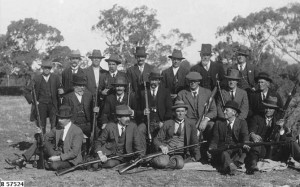 State Library of South Australia B57254. Shooting party, possibly at Quorn, about 1910.
State Library of South Australia B57254. Shooting party, possibly at Quorn, about 1910.
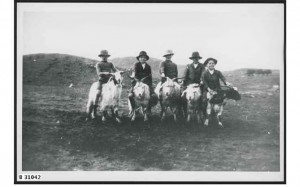
State Library of South Australia B 31042. A group of boys ready for a goat race at Blinman in 1920.
Shows
– Quorn Royal Agricultural, Horticultural and Floricultural Society was set up in 1880, and the first show was held that year. More than 100 agricultural implements were exhibited, and attendance was estimated at being between 1200 and 1500 people, which shows how much
interest there was. Many people must have travelled long distances to see the show.
– Quorn originally had a separate showground, but in 1932 the show activities were moved to the Quorn Oval.
– Quorn Show is held in September each year. – Hawker’s first agricultural show was held in 1885. The next was held in 1891, after a couple of years of good rains had succeeded several years of severe drought.
– There were huge displays of farm equipment and machinery – one merchant was said to have needed twenty railway trucks to carry implements (Mincham 1980:95).
– Hawker then had shows in 1893, 94 and 95 – and then there was a gap till 1910. A run of good seasons led to shows being held four years in a row at Hawker – 1920-23.
– Hawker no longer holds shows.
– Remaining shows in the region are Quorn (September); Wilmington (September); Mt Remarkable (Melrose) and Jamestown in October. – You can check show dates and contacts on the SA country shows website http://www.sacountryshows.com/pages/sa-country-shows.php
